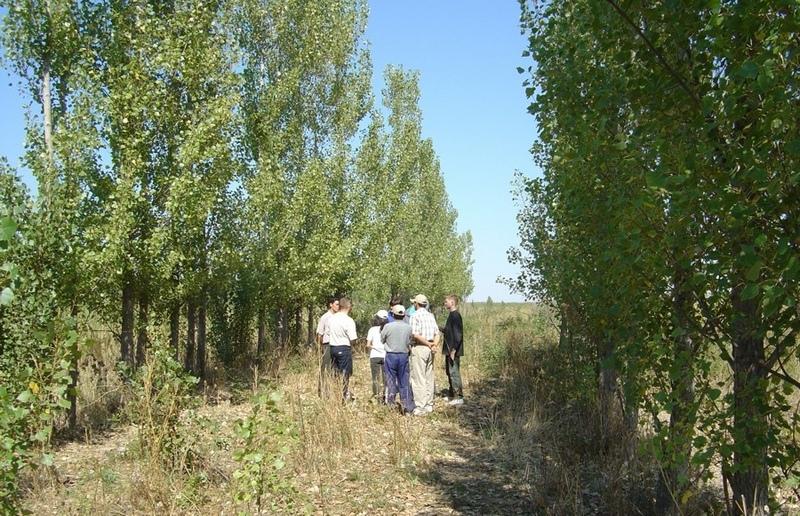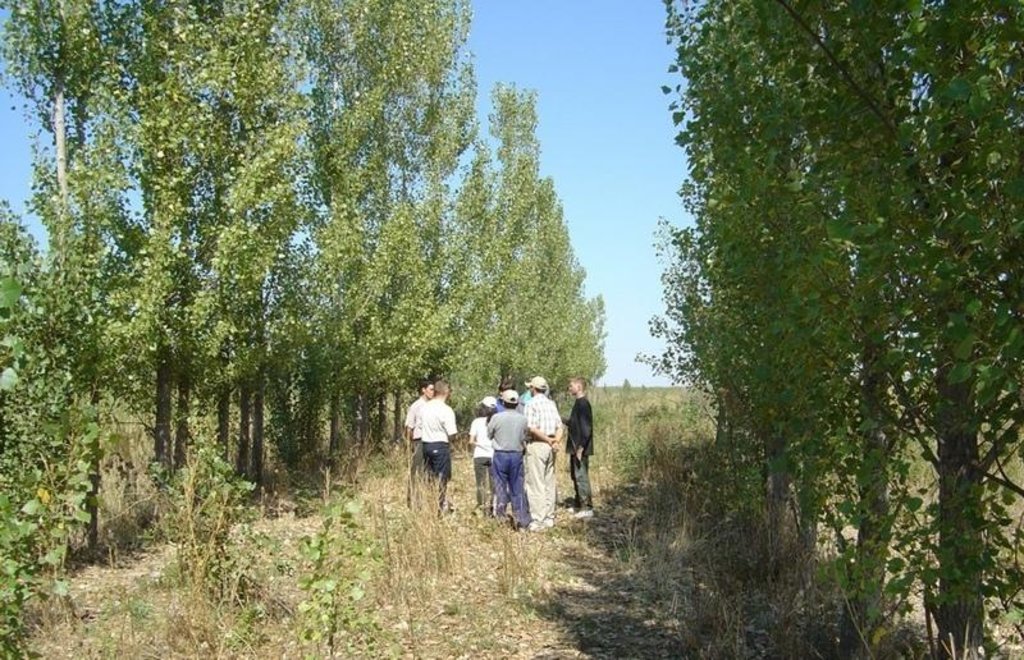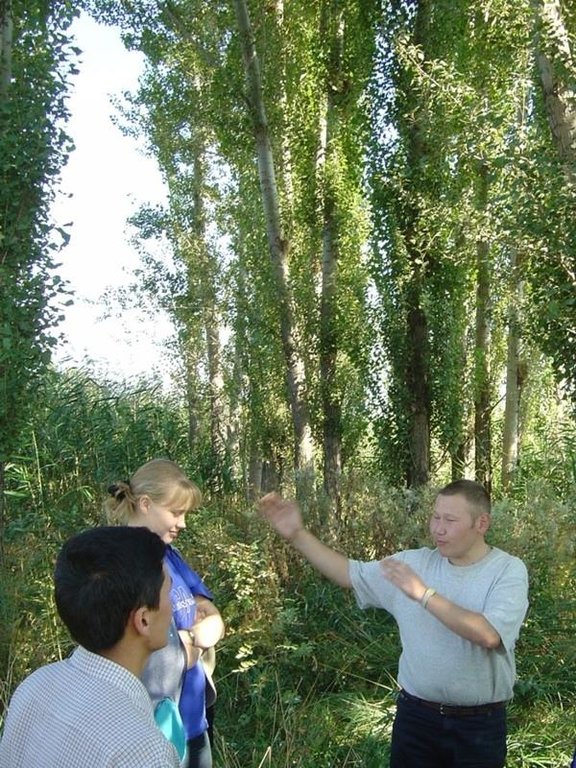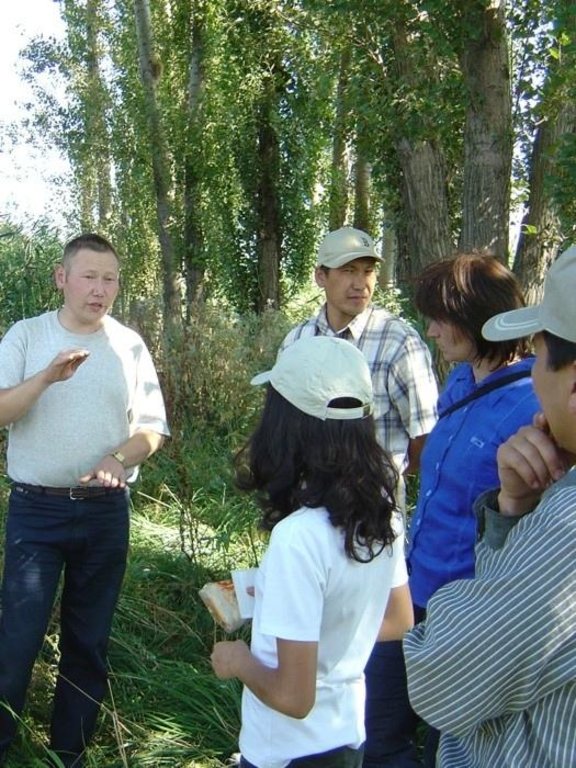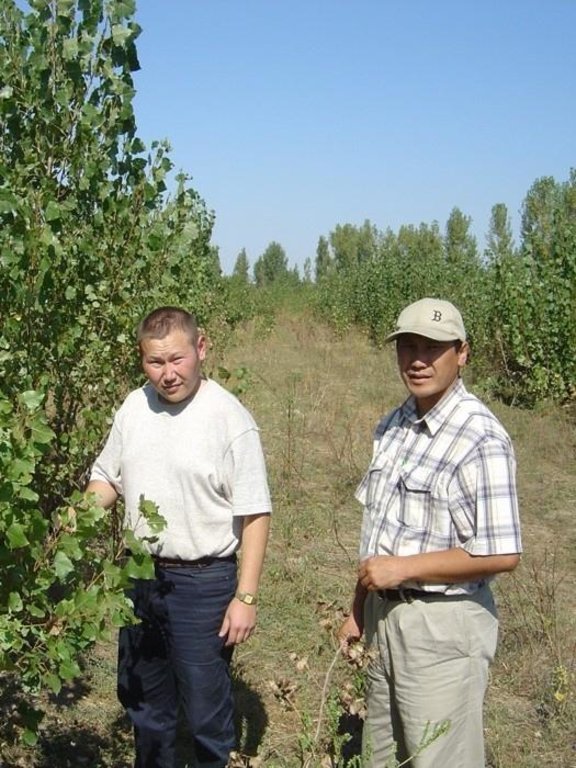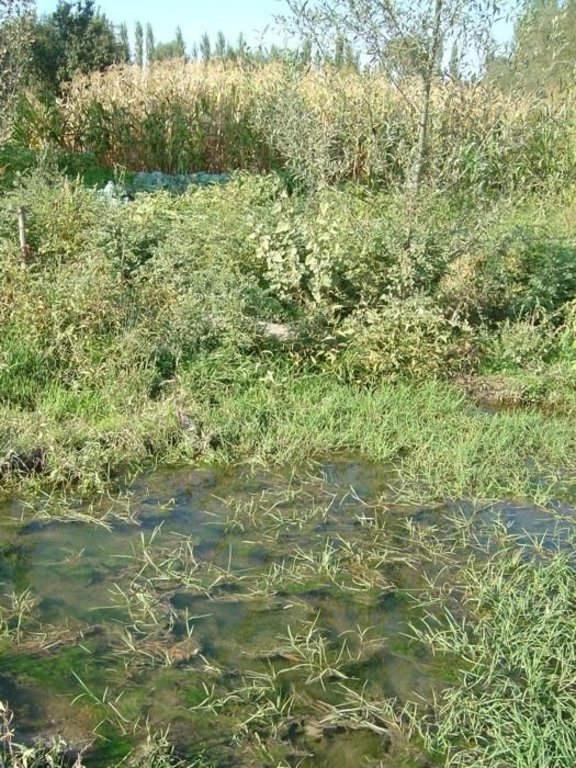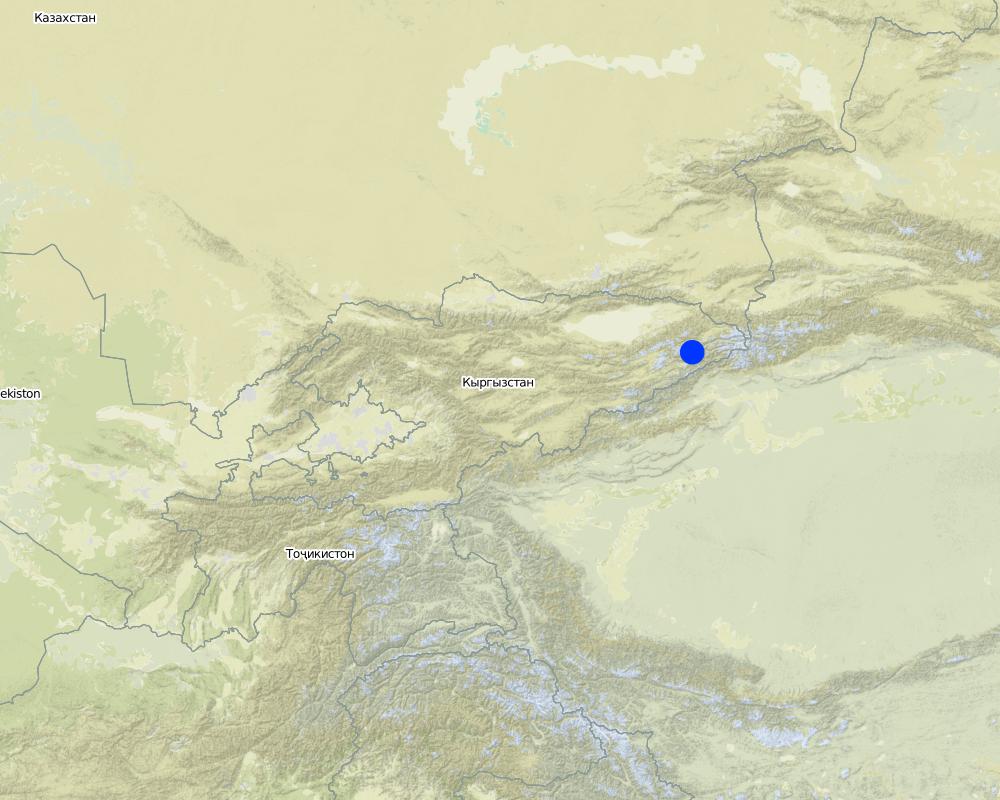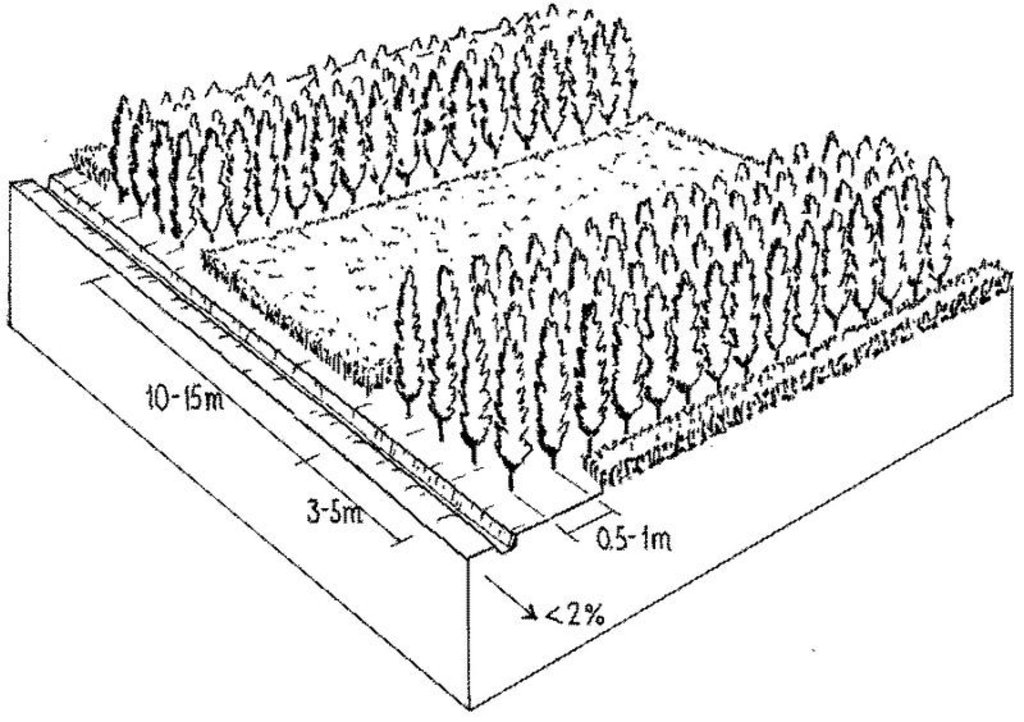Poplar trees for bio-drainage [ប្រទេសកៀហ្ស៊ីស៊ីស្ថាន]
- ការបង្កើត៖
- បច្ចុប្បន្នភាព
- អ្នកចងក្រង៖ Abdybek Asanaliev
- អ្នកកែសម្រួល៖ –
- អ្នកត្រួតពិនិត្យច្រើនទៀត៖ David Streiff, Deborah Niggli, Alexandra Gavilano
bio-drainage, reduce salinity, favourable microclimate for for plant growth
technologies_1098 - ប្រទេសកៀហ្ស៊ីស៊ីស្ថាន
ពិនិត្យមើលគ្រប់ផ្នែក
ពង្រីកមើលទាំងអស់ បង្រួមទាំងអស់1. ព័ត៌មានទូទៅ
1.2 ព័ត៌មានលម្អិតពីបុគ្គលសំខាន់ៗ និងស្ថាប័នដែលចូលរួមក្នុងការវាយតម្លៃ និងចងក្រងឯកសារនៃបច្ចេកទេស
អ្នកជំនាញឯកទេស SLM:
ឈ្មោះគម្រោងដែលបានចងក្រងឯកសារ/ វាយតម្លៃលើបច្ចេកទេស (បើទាក់ទង)
Book project: where the land is greener - Case Studies and Analysis of Soil and Water Conservation Initiatives Worldwide (where the land is greener)ឈ្មោះអង្គភាពមួយ (ច្រើន) ដែលបានចងក្រងឯកសារ/ វាយតម្លៃបច្ចេកទេស (បើទាក់ទង)
Kyrgyz Agrarian University (Kyrgyz Agrarian University) - ប្រទេសកៀហ្ស៊ីស៊ីស្ថាន1.3 លក្ខខណ្ឌទាក់ទងទៅនឹងការប្រើប្រាស់ទិន្នន័យដែលបានចងក្រងតាមរយៈ វ៉ូខេត
អ្នកចងក្រង និង(បុគ្គលសំខាន់ៗ)យល់ព្រមទទួលយកនូវលក្ខខណ្ឌនានាទាក់ទងទៅនឹងការប្រើប្រាស់ទិន្នន័យដែលបានចងក្រងតាមរយៈវ៉ូខេត:
បាទ/ចា៎
2. ការពណ៌នាពីបច្ចេកទេស SLM
2.1 ការពណ៌នាដោយសង្ខេបពីបច្ចេកទេស
និយមន័យបច្ចេកទេស:
Poplars planted to lower the ground water table and reduce salinity where irrigation drainage systems have broken down; lucerne cultivated between the tree lines.
2.2 ការពណ៌នាលម្អិតពីបច្ចេកទេស
ការពណ៌នា:
In irrigated areas of Central Asia, the drainage system introduced during soviet times has broken down due to lack of maintenance. As a result, water tables have been rising and soil salinity increasing. In the Chui Valley, which is the main crop production area in Kyrgyzstan, approximately 90% of the cultivated land is irrigated for wheat, maize, sugar beet, lucerne and vegetables. Of this, approximately one third (ca. 320,000 ha) is degraded due to loss of fertility, salinisation and waterlogging.
The individual initiative described here - poplar planting - has been applied on a degraded plain (about 400 m a.s.l.), under semi-arid conditions on a plot of 5 hectares. Though initially planted for timber, an important side effect was noted by the farmer in question. Poplar trees, well known for their tolerance to waterlogging and salinity, provide ‘bio-drainage’. Excess water is rapidly taken up by the root system and transpired through the dense foliage. Within the plantation the humidity level of the lower layers of air is increased, thus reducing the influence of the dry, hot winds. A more favourable microclimate for plant growth is thus created. Simultaneously the original purpose of planting - to obtain cheap timber and firewood - is achieved through the rapid growth of the trees: there is a severe shortage of wood locally.
The varieties used include the local Populus alba and Populus nigra as well as a hybrid from Kazakhstan, P. pyramidalis. The trees are planted in rows about 5 metres wide, separated by 10-15 metre strips planted with Medicago sativa (lucerne) and Bromus inermis (a grass), both of which are grown for hay (see technical drawing). Around 3,000 saplings are needed per hectare. The young poplars require irrigating during the first year before their roots can reach the water table. The trees are weeded and their lower branches pruned to encourage straight and fast growth. They are thinned twice before they are 14 years old: these thinnings can be sold. The poplars then remain until they are 20-25 years old and suitable for felling. The output of commercial timber of a poplar plantation is 3,000 m2 per hectare (1 m2 per mature tree). Slow-growing/sick trees, as well as pruned branches, are used as firewood - which can amount to 20-30 m3 per hectare. The cycle begins again after approximately 10 years, when new saplings are planted between the existing, thinned, lines of poplars. Desalinisation of the soil takes 10 years or a little longer, when it again becomes suitable for irrigated cereal cropping.
2.3 រូបភាពនៃបច្ចេកទេស
2.5 ប្រទេស/តំបន់/ទីតាំងកន្លែង ដែលបច្ចេកទេសត្រូវបានអនុវត្ត និងបានគ្រប់ដណ្តប់ដោយការវាយតម្លៃនេះ
ប្រទេស:
ប្រទេសកៀហ្ស៊ីស៊ីស្ថាន
តំបន់/រដ្ឋ/ខេត្ត:
Besh-Terek, Chui valley,
បញ្ជាក់ពីការសាយភាយនៃបច្ចេកទេស:
- ត្រូវបានផ្សព្វផ្សាយត្រឹមតំបន់មួយ
ប្រសិនបើបច្ចេកទេសត្រូវបានសាយភាយពាសពេញតំបន់ណាមួយ បញ្ជាក់ទំហំផ្ទៃដីអនុវត្តន៍ (គិតជា គ.ម2):
0,05
មតិយោបល់:
Total area covered by the SLM Technology is 0.05 km2.
Map
×2.7 ការណែនាំពីបច្ចេកទេស
សូមបញ្ជាក់តើបច្ចេកទេសត្រូវបានណែនាំឱ្យអនុវត្តដោយរបៀបណា:
- ពេលកំពុងពិសោធន៍
3. ចំណាត់ថ្នាក់នៃបច្ចេកទេស SLM
3.1 គោលបំណងចម្បង (១ ឬច្រើន) នៃបច្ចេកទេសនេះ
- កាត់បន្ថយ, បង្ការ, ស្តារឡើងវិញនូវការធ្លាក់ចុះគុណភាពដី
3.2 ប្រភេទដីប្រើប្រាស់មួយប្រភេទ (ច្រើនប្រភេទ) ដែលបានអនុវត្តបច្ចេកទេស
ដីប្រើប្រាស់ចម្រុះនៅលើដីតែមួយ:
បាទ/ចា៎
បញ្ជាក់ពីប្រភេទដីច្រើនប្រភេទ (ដីដាំដំណាំ/ដីចិញ្ចឹមសត្វ/ដីព្រៃឈើ):
- កសិរុក្ខកម្ម

ដីដាំដំណាំ
- ដំណាំប្រចាំឆ្នាំ
ដំណាំប្រចាំឆ្នាំ - បញ្ជាក់ប្រភេទដំណាំ:
- ដំណាំចំណីសត្វ - alfalfa
ចំនួនសារដែលដាំដំណាំក្នុងមួយឆ្នាំ:
- 1
សូមបញ្ជាក់:
Longest growing period in days: 180; Longest growing period from month to month: Mar - Sep

ដីព្រៃ/ដីដាំដើមឈើ
ប្រភេទឈើ:
- Populus species
មតិយោបល់:
Major food crop: Poplar, lucerne (alfalfa), wheat
Major land use problems (compiler’s opinion): Irrigation drainage systems have deteriorated (silted up, choked with weeds and reeds) due to lack of maintenance. This has led to a raised water table, waterlogging and increased salinity, thus seriously affecting productivity and making cultivation of some crops impossible. Farmers’ incomes have significantly reduced as a result.
Constraints of wastelands / deserts / glaciers / swamps
3.5 ក្រុម SLM ដែលបច្ចេកទេសស្ថិតនៅក្នុង
- គ្រប់គ្រងការដាំព្រៃឈើ
- ធ្វើឱ្យប្រសើរឡើងគម្របដី/ ដំណាំគម្របដី
3.6 វិធានការ SLM ដែលបញ្ចូលនូវបច្ចេកទេស

វិធានការក្សេត្រសាស្ត្រ
- A1: ដំណាំ/គម្របដី

វិធានការរុក្ខជាតិ
- V1: ឈើធំៗ និងដើមឈើតូចៗ
មតិយោបល់:
Type of agronomic measures: legume inter-planting
Type of vegetative measures: aligned: -against wind
3.7 កំណត់ប្រភេទនៃការធ្លាក់ចុះគុណភាពដីសំខាន់ៗដែលបច្ចេកទេសនេះបានដោះស្រាយ

ការធ្លាក់ចុះសារធាតុគីមីក្នុងដី
- Cn: ការថយចុះជីជាតិ និងកាត់បន្ថយបរិមាណសារធាតុសរីរាង្គ (មិនកើតឡើងដោយការហូរច្រោះទេ)
- Cs: សារធាតុប្រៃ/អាល់កាឡាំង

ការបាត់បង់រូបសាស្ត្រនៃដី
- Pw: ទឹកនៅដក់ជាប់
មតិយោបល់:
Secondary types of degradation addressed: Cn: fertility decline and reduced organic matter content
3.8 ការពារ កាត់បន្ថយ ឬស្តារឡើងវិញនៃការធ្លាក់ចុះគុណភាពដី
បញ្ជាក់ពីគោលដៅរបស់បច្ចេកទេស ដែលផ្តោតទៅការធ្លាក់ចុះគុណភាពដី:
- ការជួសជុល/ ស្តារឡើងវិញនៃឱនភាពដីធ្ងន់ធ្ងរ
4. បច្ចេកទេសជាក់លាក់ សកម្មភាពអនុវត្ត ធាតុចូល និងថ្លៃដើម
4.1 គំនូសបច្ចេកទេសនៃបច្ចេកទេសនេះ
លក្ខណៈពិសេសនៃបច្ចេកទេស (ទាក់ទងនឺងគំនូរបច្ចេកទេស):
Alternating strips of poplar trees for bio-drainage, and lucerne for fodder. Drainage channels (left) are spaced at 50 metres apart.
Technical knowledge required for field staff / advisors: moderate
Technical knowledge required for land users: moderate
Main technical functions: lower ground water level, decrease waterlogging & improve soil fertility, reduce risk of salinisation
Secondary technical functions: reduction in wind speed, increased air humidity & cooling effect
Aligned: -against wind
Vegetative material: T : trees / shrubs
Trees/ shrubs species: Poplars (Populus alba, Populus nigra, P.pyramidalis)
ឈ្មោះអ្នកនិពន្ធ:
Mats Gurtner
4.2 ព័ត៌មានទូទៅដែលពាក់ព័ន្ធនឹងការគណនាធាតុចូល និងថ្លៃដើម
កំណត់រូបិយប័ណ្ណសម្រាប់ថ្លៃដើម:
- ដុល្លារ
4.3 សកម្មភាពបង្កើត
| សកម្មភាព | រយៈពេល (រដូវកាល) | |
|---|---|---|
| 1. | Set up tree nursery one year before planting: take cuttings about | |
| 2. | Demarcate lines in field. | |
| 3. | Dig drainage trenches in the marshy area (50 cm deep, 50 cm wide, | (end of summer, early autumn) |
| 4. | Plough where seedlings of the poplars are to be planted. | |
| 5. | Transplant tree seedlings from the nursery to the field . | in spring |
| 6. | Irrigate the seedlings by furrow for one year. | |
| 7. | Protect the area from animals. | |
| 8. | Plant lucerne . | in first year after planting of poplars |
4.4 ថ្លៃដើម និងធាតុចូលដែលត្រូវការសម្រាប់ការបង្កើតបច្ចេកទេស
| បញ្ជាក់ពីធាតុចូល | ឯកតា | បរិមាណ | ថ្លៃដើមក្នុងមួយឯកតា | ថ្លៃធាតុចូលសរុប | % នៃថ្លៃដើមដែលចំណាយដោយអ្នកប្រើប្រាស់ដី | |
|---|---|---|---|---|---|---|
| កម្លាំងពលកម្ម | All the Labour | ha | 1,0 | 350,0 | 350,0 | 100,0 |
| កម្លាំងពលកម្ម | Machine use | ha | 1,0 | 100,0 | 100,0 | 100,0 |
| កម្លាំងពលកម្ម | Animal traction | ha | 1,0 | 5,0 | 5,0 | 100,0 |
| សម្ភារៈ | Tools | ha | 1,0 | 15,0 | 15,0 | |
| សម្ភារៈដាំដុះ | Seeds | ha | 1,0 | 20,0 | 20,0 | 1,0 |
| សម្ភារៈដាំដុះ | Seedlings | ha | 1,0 | 350,0 | 350,0 | 1,0 |
| សម្ភារៈដាំដុះ | Nursery | ha | 1,0 | 80,0 | 80,0 | 1,0 |
| ថ្លៃដើមសរុបក្នុងការបង្កើតបច្ចេកទេស | 920,0 | |||||
| ថ្លៃដើមសរុបក្នុងការបង្កើតបច្ចេកទេសគិតជាដុល្លារ | 920,0 | |||||
មតិយោបល់:
Duration of establishment phase: 24 month(s)
4.5 សកម្មភាពថែទាំ
| សកម្មភាព | ពេលវេលា/ ភាពញឹកញាប់ | |
|---|---|---|
| 1. | Prune lower branches of the trees to encourage tall and straight | |
| 2. | Continue protection of the plot (because of lucerne). | |
| 3. | Cut lucerne for hay . | /4 times per year |
| 4. | Weed control (main weeds are Chenopodium album, |
4.6 កំណត់ថ្លៃដើមសម្រាប់ការថែទាំ/ សកម្មភាពរបស់បច្ចេកទេស (ក្នុងរយៈពេលមួយឆ្នាំ)
| បញ្ជាក់ពីធាតុចូល | ឯកតា | បរិមាណ | ថ្លៃដើមក្នុងមួយឯកតា | ថ្លៃធាតុចូលសរុប | % នៃថ្លៃដើមដែលចំណាយដោយអ្នកប្រើប្រាស់ដី | |
|---|---|---|---|---|---|---|
| កម្លាំងពលកម្ម | All the labour | ha | 1,0 | 25,0 | 25,0 | 100,0 |
| សម្ភារៈ | Machine use | ha | 1,0 | 5,0 | 5,0 | 100,0 |
| ថ្លៃដើមសរុបសម្រាប់ការថែទាំដំណាំតាមបច្ចេកទេស | 30,0 | |||||
| ថ្លៃដើមសរុបសម្រាប់ការថែទាំដំណាំតាមបច្ចេកទេសគិតជាដុល្លារ | 30,0 | |||||
មតិយោបល់:
Machinery/ tools: shovel, axe, saw
Labour for establishment and maintenance are provided by the farmer and his family. After 10–15 years trees are
thinned for timber and the cycle begins again – with reduced establishment costs: new saplings are planted between the
existing, thinned, lines of poplars. On two sides the plot is protected by a drainage ditch and a concrete canal protect the plot respectively. Furthermore, there is an agreement with the neighbours not to let the animals graze the lucerne. However after the last cut of lucerne animals are allowed to graze the plot.
5. លក្ខណៈបរិស្ថានធម្មជាតិ និងមនុស្ស
5.1 អាកាសធាតុ
បរិមាណទឹកភ្លៀងប្រចាំឆ្នាំ
- < 250 មម
- 251-500 មម
- 501-750 មម
- 751-1,000 មម
- 1,001-1,500 មម
- 1,501-2,000 មម
- 2,001-3,000 មម
- 3,001-4,000 មម
- > 4,000 មម
តំបន់កសិអាកាសធាតុ
- មានភ្លៀងតិចតួច
5.2 សណ្ឋានដី
ជម្រាលជាមធ្យម:
- រាបស្មើ (0-2%)
- ជម្រាលតិចតួច (3-5%)
- មធ្យម (6-10%)
- ជម្រាលខ្ពស់បន្តិច (11-15%)
- ទីទួល (16-30%)
- ទីទួលចោត (31-60%)
- ទីទួលចោតខ្លាំង (>60%)
ទម្រង់ដី:
- ខ្ពង់រាប
- កំពូលភ្នំ
- ជម្រាលភ្នំ
- ជម្រាលទួល
- ជម្រាលជើងភ្នំ
- បាតជ្រលងភ្នំ
តំបន់តាមរយៈកម្ពស់ :
- 0-100 ម
- 101-500 ម
- 501-1,000 ម
- 1,001-1,500 ម
- 1,501-2,000 ម
- 2,001-2,500 ម
- 2,501-3,000 ម
- 3,001-4,000 ម
- > 4,000 ម
5.3 ដី
ជម្រៅដីជាមធ្យម:
- រាក់ខ្លាំង (0-20 សម)
- រាក់ (21-50 សម)
- មធ្យម (51-80 សម)
- ជ្រៅ (81-120 សម)
- ជ្រៅខ្លាំង (> 120 សម)
វាយនភាពដី (ស្រទាប់លើ):
- មធ្យម (ល្បាយ, ល្បាប់)
សារធាតុសរីរាង្គនៅស្រទាប់ដីខាងលើ:
- មធ្យម (1-3%)
បើអាចសូមភ្ជាប់ការពណ៌នាពីដីឱ្យបានច្បាស់ ឬព័ត៌មានដែលអាចទទួលបាន ឧ. ប្រភេទដី, pH ដី/ ជាតិអាស៊ីត, សមត្ថភាពផ្លាស់ប្តូរកាចុង, វត្តមាននីត្រូសែន, ភាពប្រៃ ។ល។:
Soil fertility is very low - low
Soil drainage / infiltration is poor
5.6 លក្ខណៈនៃអ្នកប្រើប្រាស់ដីដែលអនុវត្តបច្ចេកទេស
ទីផ្សារនៃប្រព័ន្ធផលិតកម្ម:
- សម្រាប់ហូបក្នុងគ្រួសារ (ផ្គត់ផ្គង់ខ្លួនឯង)
- ពាណិជ្ជកម្ម/ ទីផ្សារ
ចំណូលក្រៅកសិកម្ម:
- 10-50% នៃចំណូល
សូមបញ្ជាក់ពីលក្ខណៈពាក់ព័ន្ធផ្សេងទៀតអំពីអ្នកប្រើប្រាស់ដី:
Off-farm income specification: this individual is an employee of the regional agricultural department and has a small business
Market orientation of production system: Thinned poplar saplings, timber and firewood from prunings for market
5.7 ទំហំផ្ទៃដីជាមធ្យមនៃដីប្រើប្រាស់ដោយអ្នកប្រើប្រាស់ដី ក្នុងការអនុវត្តបច្ចេកទេស
- < 0.5 ហិកតា
- 0.5-1 ហិកតា
- 1-2 ហិកតា
- 2-5 ហិកតា
- 5-15 ហិកតា
- 15-50 ហិកតា
- 50-100 ហិកតា
- 100-500 ហិកតា
- 500-1,000 ហិកតា
- 1,000-10,000 ហិកតា
- > 10,000 ហិកតា
5.8 ភាពជាម្ចាស់ដី កម្មសិទ្ធប្រើប្រាស់ដី និងកម្មសិទ្ធប្រើប្រាស់ទឹក
ភាពជាម្ចាស់ដី:
- ឯកជន មានកម្មសិទ្ធ
កម្មសិទ្ធិប្រើប្រាស់ដី:
- ឯកជន
6. ផលប៉ះពាល់ និងការសន្និដ្ឋាន
6.1 ផលប៉ះពាល់ក្នុងបរិវេណអនុវត្តបច្ចេកទេសដែលកើតមាន
ផលប៉ះពាល់លើសេដ្ឋកិច្ចសង្គម
ផលិតផល
ផលិតកម្មចំណីសត្វ
មតិយោបល់/ ការបញ្ជាក់:
Lucerne between tree lines
គុណភាពចំណីសត្វ
មតិយោបល់/ ការបញ្ជាក់:
Lucerne between tree lines
ផលិតកម្មឈើ
ចំណូល និងថ្លៃដើម
ចំណូលក្នុងកសិដ្ឋាន
បន្ទុកការងារ
ផលប៉ះពាល់ទៅលើសេដ្ឋកិច្ចសង្គមផ្សេងៗ
input contstraints
មតិយោបល់/ ការបញ្ជាក់:
Not all the farmers have enough resources for introduction of this technology (equipment,
main benefit
មតិយោបល់/ ការបញ្ជាក់:
However, short-term benefit from lucerne as fodder and from firewood through pruning
ផលប៉ះពាល់ទៅលើវប្បធម៌សង្គម
ចំណេះដឹង SLM / ការធ្លាក់ចុះគុណភាពដី
ផលប៉ះពាល់ទៅលើអេកូឡូស៊ី
វដ្តទឹក/លំហូរ
ប្រព័ន្ធបង្ហូរទឹក
ដី
សំណើមដី
ការកាត់បន្ថយហានិភ័យនៃគ្រោះមហន្តរាយ និងគ្រោះអាកាសធាតុ
ហានិភ័យនៃភ្លើងឆេះព្រៃ
ល្បឿនខ្យល់
ផលប៉ះពាល់ទៅលើអេកូឡូស៊ីផ្សេងៗ
soil fertility
មតិយោបល់/ ការបញ្ជាក់:
Due to lucerne: 100–130 kg of N
biodiversity
6.2 ផលប៉ះពាល់ក្រៅបរិវេណអនុវត្តបច្ចេកទេសដែលកើតមាន
ខ្យល់នាំយកនូវធូរលី
General drop of water table
6.4 ការវិភាគថ្លៃដើម និងអត្ថប្រយោជន៍
តើផលចំណេញ និងថ្លៃដើមត្រូវបានប្រៀបធៀបគ្នាយ៉ាងដូចម្តេច (ទស្សនៈរបស់អ្នកប្រើប្រាស់ដី)?
រយៈពេលខ្លី:
អវិជ្ជមាន
រយៈពេលវែង:
វិជ្ជមានខ្លាំង
តើផលចំណេញ និងការថែទាំ/ ជួសជុលត្រូវបានប្រៀបធៀបគ្នាយ៉ាងដូចម្តេច (ទស្សនៈរបស់អ្នកប្រើប្រាស់ដី)?
រយៈពេលខ្លី:
វិជ្ជមាន
រយៈពេលវែង:
វិជ្ជមានខ្លាំង
6.5 ការទទួលយកបច្ចេកទេស
- តែមួយករណី /ពិសោធន៍
បើអាច សូមបញ្ជាក់ពីបរិមាណ (ចំនួនគ្រួសារ និង/ ឬតំបន់គ្របដណ្តប់):
1 household
ក្នុងចំណោមគ្រួសារទាំងអស់ដែលបានអនុវត្តបច្ចេកទេស តើមានប៉ុន្មានគ្រួសារដែលចង់ធ្វើដោយខ្លួនឯង ដោយមិនទទួលបានសម្ភារៈលើកទឹកចិត្ត/ប្រាក់ឧបត្ថម្ភ?:
- 0-10%
មតិយោបល់:
There is a little trend towards spontaneous adoption of the Technology
Comments on adoption trend: A single farmer has developed this technology. It should be possible to spread the technology among other farmers but financial support (eg interest-free credit) will need to be provided. A recent assessment has showed that there is growing interest in the system by farmers in the region. Additionally, in the lower Yanvan Valley of Tajikistan, a similar bio-drainage system has been described - using poplars and mulberry trees. In that situation wheat is planted in association with the trees.
6.7 ភាពខ្លាំង/ គុណសម្បត្តិ/ ឱកាសនៃបច្ចេកទេស
| ភាពខ្លាំង/ គុណសម្បត្តិ/ ឱកាស ទស្សនៈរបស់បុគ្គលសំខាន់ៗ |
|---|
|
Positive ecological effect: salinity and area of marshy land can be reduced and waterlogged soils reclaimed How can they be sustained / enhanced? Awareness raising and training of farmers to show the effect of poplar trees on reduction of waterlogging and salinisation. |
|
Rapid benefit through the production of lucerne and grass. Long-term production of valuable firewood and timber (both are in short supply) How can they be sustained / enhanced? Show the economic benefits of additional lucerne production and timber and firewood; demonstrate marketing opportunities. |
6.8 ភាពខ្សោយ/ គុណវិបត្តិ/ ហានិភ័យនៃបច្ចេកទេស និងវិធីសាស្ត្រដោះស្រាយ
| ភាពខ្សោយ/ គុណវិបត្តិ/ ហានិភ័យ ទស្សនៈរបស់អ្នកចងក្រងឬបុគ្គលសំខាន់ៗ | តើបច្ចេកទេសទាំងនោះបានដោះស្រាយបញ្ហាដូចម្តេច? |
|---|---|
| The implementation of the technology is not possible for all land users due to input and labour constraints |
Financial support, better organisation/ share of equipment. |
| Major benefit from timber production comes only after 25 years |
Create awareness about additional short-term benefits, especially firewood and fodder, as well as the long-term effects and the sustainability of the system. |
|
Cannot be replicated by all farmers in the valley at the same density as the market for trees (timber, firewood) will be saturated, and trees can never completely take the place of irrigated food crops: nevertheless the benefits will extend to those growers through the drainage function of the poplars |
A new overall production system will have to be worked out for the region. |
|
The case reported here works in its current design because of its isolated ‘island effect’: if more farmer grew poplar, the same bio-drainage effect could be achieved over the whole valley at a lower density of trees per unit area, implying a larger proportion of cultivable land. |
7. ឯកសារយោង និងវេបសាយ
7.1 វិធីសាស្ត្រ/ ប្រភពនៃព័ត៌មាន
7.2 ឯកសារយោងដែលបានចេញផ្សាយ
ចំណងជើង អ្នកនិពន្ធ ឆ្នាំ ISBN:
Budaychiev D (2002) The prospects for hybrid poplar forest plantations. Resolving problems and the strategy of reformingagrarian science. News of Kyrgyz Agrarian Academy Vol. 2, Issue 3, 4.1 Bishkek
ការតភ្ជាប់ និងម៉ូឌុល
ពង្រីកមើលទាំងអស់ បង្រួមទាំងអស់ការតភ្ជាប់
គ្មានការតភ្ជាប់
ម៉ូឌុល
គ្មានម៉ូឌុល


